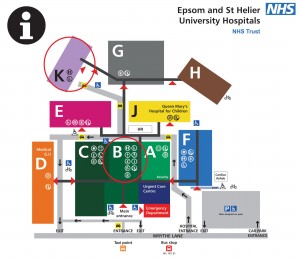As regular readers of this website will know, we at KOSHH are not normally prone to announcing days of national pride. We feel that the National Health Service, as originally conceived is the finest creation of any nation, this post is perhaps more about our neighbouring hospital which happens to be named after the patron saint of England.
As those who've been following our coverage of the "Estates Review" debacle will know, the Epsom & St Helier Trust have been looking very hard for reasons to describe the premises of Epsom hospital, St Helier Hospital, and Queen Mary's Hospital for Children as not fit for purpose, in order to argue that those three hospitals should be closed, and replaced by ONE new "Centre".
Safe, High Quality Care
In doing so, we believe that they are rather scraping the barrel, as these hospitals, quite apart from being located where the people they serve need them, are regularly producing excellent results, including recently scoring their best ever safety score, ranking in the top quartile of safe hospitals in the country.
At a recent event, held on the 19th of March, one argument the trust made was that the layout of St Helier Hospital was such that the porters in the hospital had to regularly walk excessive distances from one place to the other. They even presented this information in a slide, an excerpt of which can be seen below (click the table below to see the full slide).
As you can see, we have three journeys listed, all within St Helier hospital, using that most precise, and uniform measurement unit of "number of steps". Obviously far more precise than good old fashioned yards, or metres.

Map of St Helier Hospital. We have circled the K block and the B block in red to show the start and end points of the longest journey listed above. Note: This image is not to scale.
So, and here's where we will start to explain what this has to do with St George, just for comparison, KOSHH campaigners went along to our neighbouring hospital in Tooting, St George's to do a little bit of comparison.
We took steps to ensure that we didn't lose count of our steps, and relied upon the technology offered by a smart-watch, which has the advantage of being able to track location using the global positioning sattelite system (GPS) but also the good, old fashioned, and not terribly accurate measure of step counting.
 To begin with, we took a journey which many patients will make regularly, and repeatedly, from the Cardiothoracic Outpatients reception, to the Phlebotomy department. That came in at 581 steps, and despite walking briskly (and not pushing a patient in a wheelchair, or a hospital bed), took 6 minutes and 33 seconds to complete. A full 181 steps more than the longest example journey cited by the Epsom & St Helier Trust. It's probably worth pointing out that this journey involved walking through lots of "long corridors" and a fair few links between buildings (see this post to explain why this is relevant).
To begin with, we took a journey which many patients will make regularly, and repeatedly, from the Cardiothoracic Outpatients reception, to the Phlebotomy department. That came in at 581 steps, and despite walking briskly (and not pushing a patient in a wheelchair, or a hospital bed), took 6 minutes and 33 seconds to complete. A full 181 steps more than the longest example journey cited by the Epsom & St Helier Trust. It's probably worth pointing out that this journey involved walking through lots of "long corridors" and a fair few links between buildings (see this post to explain why this is relevant).

Map of St George's hospital. We have circled in red the start and end point of our first recorded journey. Note: This image is not to scale.
As this was just a random example of a journey a patient might need to undertake, we then spoke to some hospital porters by the League of Friends shop (who by chance, happened to be just outside the waiting room for blood tests), and asked them if there were any long journeys they regularly had to undertake, and in unison they all responded by saying "Thomas Adison Unit to Buckland Ward". Interestingly, this journey involved going outside, "past moving traffic and members of the public", just like the case oulined in the Estates Review report, which we covered here. We undertook this journey, and again measured it. This time we recorded 892 steps, which took 8 minutes and 55 seconds. Almost twice as long, and twice as far as the longest example given by the Epsom & St Helier Trust - but nobody is planning on closing down St Georges (and nor should they).
Nobody is trying to justify closing St George's because it contains long corridors, and nor should they use this fallacious argument at St Helier
In both cases, for simplicity, our journeys were carried out all on the ground floor, but of course we could easily have chosen significantly longer journeys had we opted to begin or end them on different floors.
What does this mean?
In essence, this demonstrates that St Helier, being a much more compact hospital than it's neighbour, St Georges, involves significantly shorter journeys for it's hard working portering staff than it might otherwise. KOSHH therefore rejects this particular attempt to discredit it's usefulness or importance, especially when the case is being made in order to find reasons to close it down.
St George's is a wonderful hospital... and so is St Helier
St George's is a wonderful hospital, which already struggles to cope with the demands placed upon it, as is very much the case with St Helier. St Georges is much larger than St Helier, but this has never been offered as a (flimsy) argument to justify its closure and replacement with a smaller "centre".
All of us at KOSHH would like to wish all of our readers a Very Happy St George's Day!
What was also interesting was some of the quality of the estate at St George's. After our timed, "measured" journey, we took some snaps of the quality of the buildings at St George's - again, as far as we are aware, this has not (yet) been used as grounds to close it down. See what you think:



































